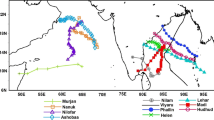India Meteorological Department (IMD) introduced the objective tropical cyclone (TC) track forecast valid for next 24 hr over the north Indian Ocean (NIO) in 2003. It further extended the validity period up to 72 hr in 2009. Here an attempt is made to evaluate the TC track forecast issued by IMD during 2003–2011 (9 years) by calculating the direct position error (DPE) and skill in track forecast. The accuracy of TC track forecast has been analysed with respect to basin of formation (Bay of Bengal, Arabian Sea and NIO as whole), season of formation (pre-monsoon and post-monsoon seasons), intensity of TCs (cyclonic storm and severe cyclonic storm or higher intensities) and type of track of TCs (climatological/straight moving and recurving/looping type). The average DPE is about 140, 262 and 386 km and skill is about 27%, 39% and 50%, respectively for 24, 48 and 72 hr forecasts over the NIO as a whole during 2009–2011. Though the DPE is higher and skill is less as compared to those in northwest Pacific and north Atlantic Ocean, the rate of decrease (increase) in DPE (skill) is higher over the NIO in recent years. The DPE (skill) over the NIO has decreased (increased) at the rate of about 7.3 km (3%) per year during 2003–2011 for 24 hr forecasts.









Similar content being viewed by others
References
Dupont T, Plu M, Caroff P and Faure G 2011 Verification of ensemble-based uncertainty circles around tropical cyclone track forecasts; Weather Forecast. 26 664–676.
Fraedrich K and Leslie M 1989 Estimates of cyclone track predictability. I: Tropical cyclones in the Australian region; Quart. J. Roy. Meteor. Soc. 115 79–92.
Heming Julian and Goerss Jim 2010 Track and structure forecasting of tropical cyclones; In: World Scientific Series on Asia Pacific Weather and Climate – Vol. 4: Global perspectives on tropical cyclones, From science to mitigation, pp. 287–323.
IMD 2003 Cyclone Manual; Published by IMD, Lodi Road, New Delhi.
IMD 2012 Tracks of cyclones and depressions over the north Indian Ocean, 1891–2011, In: Cyclone eAtlas-IMD, Regional Meteorological Centre, 50, College Road, Chennai, India.
Mohanty U C, Osuri Krishna K, Routray A, Mohapatra M and Pattanayak Sujata 2010 Simulation of Bay of Bengal Tropical Cyclones with WRF model: Impact of initial and boundary condition; Marine Geodesy 33 294–314.
Mohapatra M, Bandyopadhyay B K and Tyagi Ajit 2012 Best track parameters of tropical cyclones over the North Indian Ocean: A review; Nat. Hazards 63 1285–1317, doi: 10.1007/s11069-011-9935-0.
Mohapatra M, Sikka D R, Bandyopadhyay B K and Tyagi Ajit 2013 Outcomes and Challenges of Forecast Demonstration Project (FDP) on Landfalling Cyclones over the Bay of Bengal, Mausam 64 1–12.
Neumann C J and Mandal G S 1978 Statistical prediction of tropical storm motion over the Bay of Bengal and Arabian Sea; Indian J. Meteorol. Hydrol. Geophys. 29 487–500.
Neumann C J and Pelissier J M 1981 An analysis of Atlantic tropical cyclone forecast errors, 1970–1979; Mon. Weather Rev. 109 1248–1265.
NHC USA 2012 Forecast verification report, National Oceanic and Atmospheric Administration, http://www.nhc.noaa.gov/verification.
Osuri Krishna K, Mohanty U C, Routray A and Mohapatra M 2012 The impact of satellite-derived wind data assimilation on track, intensity and structure of tropical cyclones over the North Indian Ocean; Int. J. Rem. Sens. 33 1627–1652, doi: 10.1080/01431161.2011.596849.
Pike A C and Neumann C J 1987 The variation of track forecast difficulty among tropical cyclone basins; Weather Forecast. 2 237–241.
Plu Matthieu 2011 A new assessment of the predictability of tropical cyclone tracks; Mon. Weather Rev. 139 3600–3608.
Powell M D and Aberson S D 2001 Accuracy of United States tropical cyclone landfall forecasts in the Atlantic basin (1976–2000); Bull. Am. Meteorol. Soc. 82 2749–2767.
RSMC New Delhi 2010 Report on Cyclonic Disturbances Over The North Indian Ocean During 2009; Published by IMD, Lodi Road, New Delhi.
RSMC Tokyo 2011 Annual Report on activities of the RSMC Tokyo Typhoon Center, http://www.jma.go.jp/rsmc-hp-pub-eg/annualreport.html.
Simpson R H 1971 The decision process in hurricane forecasting; NOAA Tech. Memo, NWS SR-53 33p.
Acknowledgements
The authors are thankful to Director General of Meteorology, IMD for his support and encouragement to carry out this work. They are also thankful to Cyclone Warning Division for collection of data required for this work. The authors also thank the unknown reviewers for their valuable comments and constructive criticisms for the improvement of the manuscript.
Author information
Authors and Affiliations
Corresponding author
Rights and permissions
About this article
Cite this article
MOHAPATRA, M., NAYAK, D.P., SHARMA, R.P. et al. Evaluation of official tropical cyclone track forecast over north Indian Ocean issued by India Meteorological Department. J Earth Syst Sci 122, 589–601 (2013). https://doi.org/10.1007/s12040-013-0291-1
Received:
Revised:
Accepted:
Published:
Issue Date:
DOI: https://doi.org/10.1007/s12040-013-0291-1




